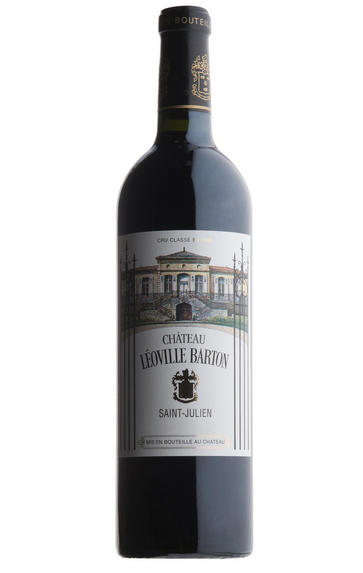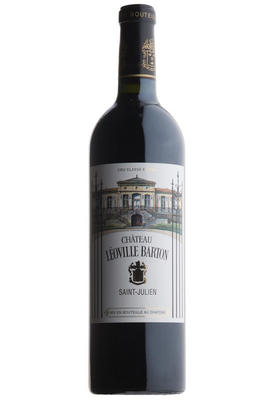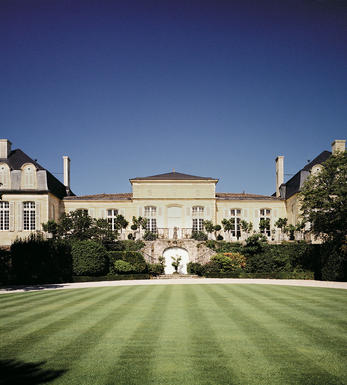
2010 Château Léoville Barton, St Julien, Bordeaux

Critics reviews
Robert M. Parker, Jr. - 28/02/2013
Tasted blind 8 Apr: Still lots of blue in the colour here. Scented and mineral. Relatively lightweight. Bone dry. A bit austere at the moment. Makes me think that these 2010s need a fair amount of weight to work? Quite long though. This wine may overtake Langoa in the long term but is certainly less expressive at this stage.
Jancis Robinson MW- jancis robinson.com, Apr 2011
James Molesworth – The Wine Spectator – Mar 2011
Robert Parker- Wine Advocate- Feb 2013
The 2010 Leoville Barton was almost impossible to evaluate because of its highly extracted, masculine, muscular style. However, it exhibits a dense purple color along with surprising amounts of oak, excruciatingly painful tannin levels, good acidity and a massive mouthfeel. One of the biggest, most backward wines of the vintage, forget it for a decade and drink it over the following 30+ years. Unfortunately, I have passed the age where it makes sense to buy a wine such as this.
Robert Parker- Wine Advocate- May 2011
About this WINE

Chateau Leoville Barton
Château Léoville Barton is the smallest portion of the great Léoville estate and has been owned by the Barton family since 1826. There is no château and the wine is made at Langoa Barton.
Léoville Barton's 48 hectares of vineyards are located in the east of the St-Julien wine appellation and lie on gravelly-clay soils. They are planted with Cabernet Sauvignon 72%, Merlot 20%, Cabernet Franc 8%. The wine is matured in oak barriques (50% new) for 18 months.
Eighth and ninth-generation family members Lilian and Damien Barton took over the reins here in 2022, after the death of Anthony Barton. Anthony was responsible for the quality at Léoville Barton soaring; his tenure saw the wine changing from a solid, mid-performing 2ème Cru Classé to one of the most exciting and scintillating wines in St. Julien. Under Lilian and Damien’s care, business at the château is better than ever.
Léoville Barton is tannic and austere in youth but with time develops the classic cedary character that is the hallmark of St. Julien, along with intensely pure blackcurrant and cassis fruit notes. Léoville Barton's wines are made for extended cellaring and tend to show at their best with 10-15 years of bottle ageing.

St Julien
St Julien is the smallest of the "Big Four" Médoc communes. Although, without any First Growths, St Julien is recognised to be the most consistent of the main communes, with several châteaux turning out impressive wines year after year.
St Julien itself is much more of a village than Pauillac and almost all of the notable properties lie to its south. Its most northerly château is Ch. Léoville Las Cases (whose vineyards actually adjoin those of Latour in Pauillac) but, further south, suitable vineyard land gives way to arable farming and livestock until the Margaux appellation is reached.
The soil is gravelly and finer than that of Pauillac, and without the iron content which gives Pauillac its stature. The homogeneous soils in the vineyards (which extend over a relatively small area of just over 700 hectares) give the commune a unified character.
The wines can be assessed as much by texture as flavour, and there is a sleek, wholesome character to the best. Elegance, harmony and perfect balance and weight, with hints of cassis and cedar, are what epitomise classic St Julien wines. At their very best they combine Margaux’s elegance and refinement with Pauillac’s power and substance.
Ch. Léoville Las Cases produces arguably the most sought-after St Julien, and in any reassessment of the 1855 Classification it would almost certainly warrant being elevated to First Growth status.
Recommended Châteaux: Ch. Léoville Las Cases, Ch.Léoville Barton, Ch Léoville Poyferré, Ch. Ducru-Beaucaillou, Ch Langoa Barton, Ch Gruaud Larose, Ch. Branaire-Ducru, Ch. Beychevelle

Cabernet Sauvignon Blend
Cabernet Sauvignon lends itself particularly well in blends with Merlot. This is actually the archetypal Bordeaux blend, though in different proportions in the sub-regions and sometimes topped up with Cabernet Franc, Malbec, and Petit Verdot.
In the Médoc and Graves the percentage of Cabernet Sauvignon in the blend can range from 95% (Mouton-Rothschild) to as low as 40%. It is particularly suited to the dry, warm, free- draining, gravel-rich soils and is responsible for the redolent cassis characteristics as well as the depth of colour, tannic structure and pronounced acidity of Médoc wines. However 100% Cabernet Sauvignon wines can be slightly hollow-tasting in the middle palate and Merlot with its generous, fleshy fruit flavours acts as a perfect foil by filling in this cavity.
In St-Emilion and Pomerol, the blends are Merlot dominated as Cabernet Sauvignon can struggle to ripen there - when it is included, it adds structure and body to the wine. Sassicaia is the most famous Bordeaux blend in Italy and has spawned many imitations, whereby the blend is now firmly established in the New World and particularly in California and Australia.


Buying options
Add to wishlist
Description
The style of this vintage is perfectly suited to Léoville-Barton. Always the epitome of elegance and breed, the wine in 2010 embodies the classical proportions of the vintage with a lovely harmony between fruit, acidity, tannin and alcohol. It is certainly destined for a long life, so put it away for 15 years at least, by which time it will be extremely rewarding.
(77% Cabernet Sauvignon, 22.5% Merlot, and 0.5% Cabernet Franc)
wine at a glance
Delivery and quality guarantee